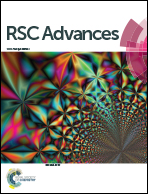Two cationic [(CuxIy)x−y]n motif based coordination polymers and their photocatalytic properties†
Abstract
Cuprous iodide (CuI)-based coordination compounds with the general chemical formula of CuI(L) are well-known for their structural diversity and strong photoluminescence and are therefore considered as promising candidates for a number of optical applications. Reported here are two cuprous iodide coordination polymers (CPs), {[Cu3I2TBA]·H2O}n (1) and {[Cu2I(HTBA)TBA]·2H2O}n (2) (HTBA = 4-(4H-1,2,4-triazol-4-yl)benzoic acid). Structures of CPs 1 and 2 are determined by single crystal X-ray diffraction and further characterized by infrared spectra (IR), elemental analyses, powder X-ray diffraction (PXRD), and thermogravimetric (TG) analyses. CPs 1 and 2 with a significant feature of novel cationic [(CuxIy)x−y]n motifs are synthesized under controlled reaction conditions via adopting HTBA as ligand. CP 1 displays a 3,6-connected net, while CP 2 shows a coordination chain. Further, the catalytic properties of CPs 1 and 2 are investigated in the degradation of methyl blue.
![Graphical abstract: Two cationic [(CuxIy)x−y]n motif based coordination polymers and their photocatalytic properties](/en/Image/Get?imageInfo.ImageType=GA&imageInfo.ImageIdentifier.ManuscriptID=C6RA10627G&imageInfo.ImageIdentifier.Year=2016)

 Please wait while we load your content...
Please wait while we load your content...